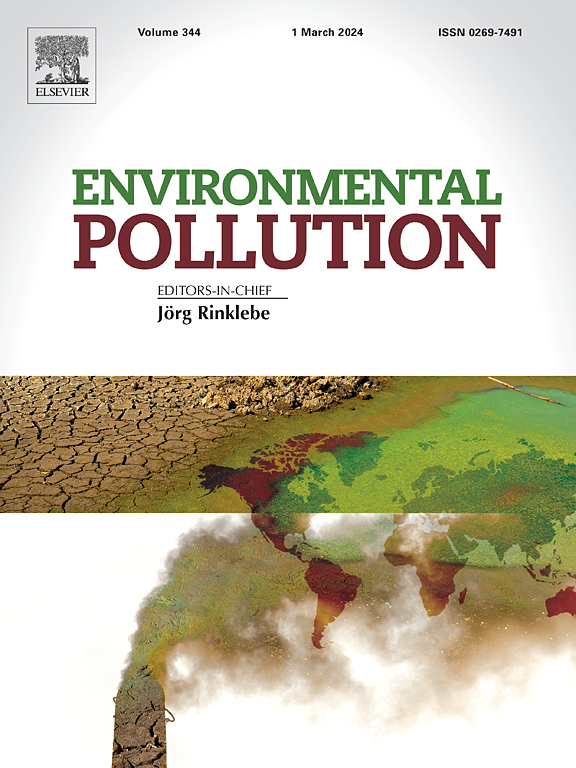Bioaccumulation of trace elements in white storks (Ciconia ciconia): Effects of age, health, and anthropogenic exposure
IF 7.6
2区 环境科学与生态学
Q1 ENVIRONMENTAL SCIENCES
引用次数: 0
Abstract
White storks (Ciconia ciconia) are recognized as effective bioindicators of environmental contamination due to their wide distribution and trophic flexibility. In this study, we analyzed blood concentrations of 47 essential, toxic, and potentially toxic elements in 189 white storks from central Spain, assessing the influence of age, health status, and anthropogenic pressure on metal accumulation. Birds were grouped into chicks, fledglings, and adults. Statistical comparisons were performed using non-parametric tests and general linear models (GLMs), depending on data distribution. Our findings indicate that age significantly affects metal accumulation, with fledglings exhibiting higher concentrations of lead (Pb, p = 0.0024), arsenic (As, p = 0.0012), cadmium (Cd, p = 0.0476), and manganese (Mn, p = 0.0467) compared to adults, suggesting increased exposure through parental feeding and trophic transfer. Health status was also a critical determinant: sick individuals showed significantly elevated levels of Cd (p < 0.0001), Pb (p < 0.0001), and As (p = 0.0166), supporting the role of metal toxicity in avian morbidity. In terms of anthropogenic exposure, storks sampled within 30 km of landfills exhibited significantly higher concentrations of As (p = 0.0002), Cd (p = 0.0118), and Hg (p = 0.0412). Individuals with foreign materials in the digestive tract also showed increased Pb (p = 0.0007) and Cd (p = 0.0008) levels. Conversely, no significant differences were found between individuals from areas of high versus low human population density. These results highlight the impact of environmental pollution on metal bioaccumulation in white storks and demonstrate the influence of landfill proximity and trophic exposure on contaminant burdens. Given their role as a sentinel species, our findings underscore the need for stricter waste management policies and continued biomonitoring efforts to mitigate toxic metal exposure in wildlife.

微量元素在白鹳体内的生物积累:年龄、健康和人为暴露的影响
白鹳(Ciconia Ciconia)由于其广泛的分布和营养灵活性而被认为是有效的环境污染生物指标。在这项研究中,我们分析了西班牙中部189只白鹳血液中47种必需、有毒和潜在有毒元素的浓度,评估了年龄、健康状况和人为压力对金属积累的影响。鸟被分为雏鸟、雏鸟和成年鸟。根据数据分布,采用非参数检验和一般线性模型(GLMs)进行统计比较。我们的研究结果表明,年龄对金属积累有显著影响,雏鸟的铅(Pb, p = 0.0024)、砷(As, p = 0.0012)、镉(Cd, p = 0.0476)和锰(Mn, p = 0.0467)浓度高于成鸟,表明通过父母喂养和营养转移增加了接触。健康状况也是一个关键的决定因素:患病个体Cd水平显著升高(p <;0.0001), Pb (p <;0.0001)和As (p = 0.0166),支持金属毒性在禽类发病中的作用。在人为暴露方面,在垃圾填埋场30 km范围内的白鹳表现出较高的砷(p = 0.0002)、镉(p = 0.0118)和汞(p = 0.0412)浓度。消化道有异物的个体也表现出Pb (p = 0.0007)和Cd (p = 0.0008)水平升高。相反,来自人口密度高和低地区的个体之间没有发现显著差异。这些结果强调了环境污染对白鹳金属生物积累的影响,并证明了垃圾填埋场附近和营养暴露对污染物负担的影响。鉴于它们作为哨兵物种的作用,我们的研究结果强调需要更严格的废物管理政策和持续的生物监测工作,以减轻野生动物的有毒金属暴露。
本文章由计算机程序翻译,如有差异,请以英文原文为准。
求助全文
约1分钟内获得全文
求助全文
来源期刊

Environmental Pollution
环境科学-环境科学
CiteScore
16.00
自引率
6.70%
发文量
2082
审稿时长
2.9 months
期刊介绍:
Environmental Pollution is an international peer-reviewed journal that publishes high-quality research papers and review articles covering all aspects of environmental pollution and its impacts on ecosystems and human health.
Subject areas include, but are not limited to:
• Sources and occurrences of pollutants that are clearly defined and measured in environmental compartments, food and food-related items, and human bodies;
• Interlinks between contaminant exposure and biological, ecological, and human health effects, including those of climate change;
• Contaminants of emerging concerns (including but not limited to antibiotic resistant microorganisms or genes, microplastics/nanoplastics, electronic wastes, light, and noise) and/or their biological, ecological, or human health effects;
• Laboratory and field studies on the remediation/mitigation of environmental pollution via new techniques and with clear links to biological, ecological, or human health effects;
• Modeling of pollution processes, patterns, or trends that is of clear environmental and/or human health interest;
• New techniques that measure and examine environmental occurrences, transport, behavior, and effects of pollutants within the environment or the laboratory, provided that they can be clearly used to address problems within regional or global environmental compartments.
 求助内容:
求助内容: 应助结果提醒方式:
应助结果提醒方式:


